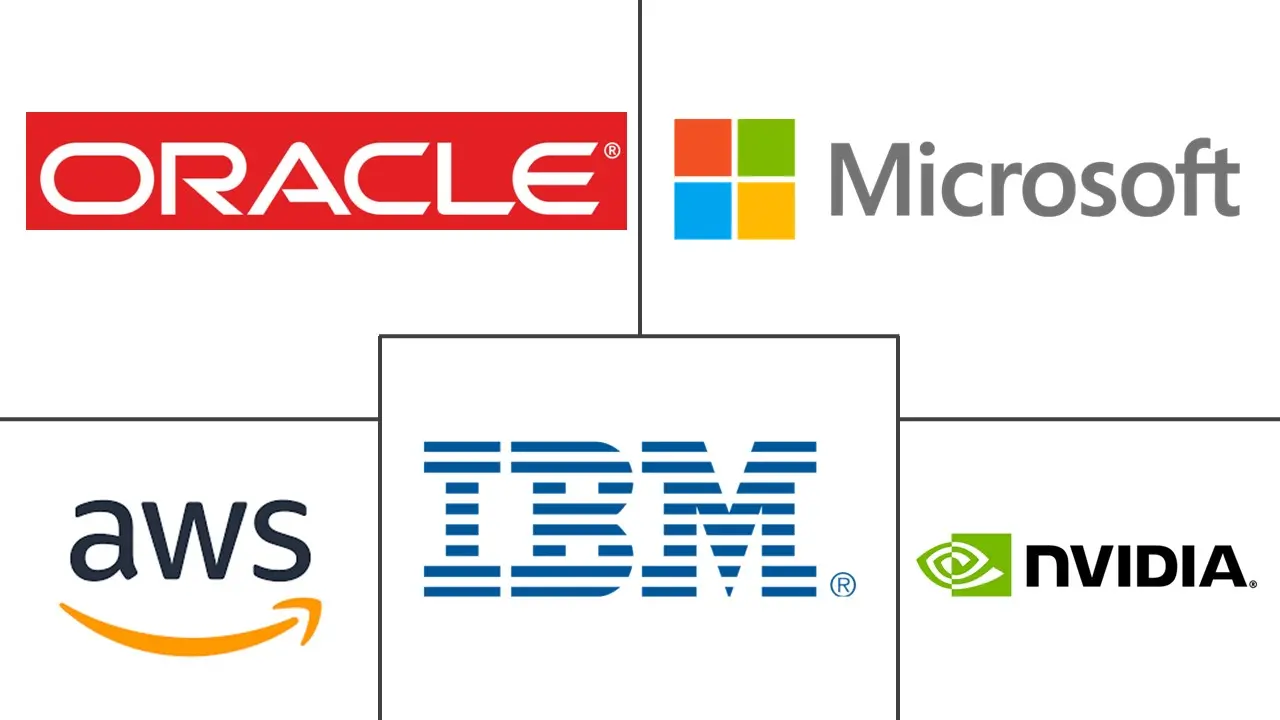GPU As A Service Market Size and Share
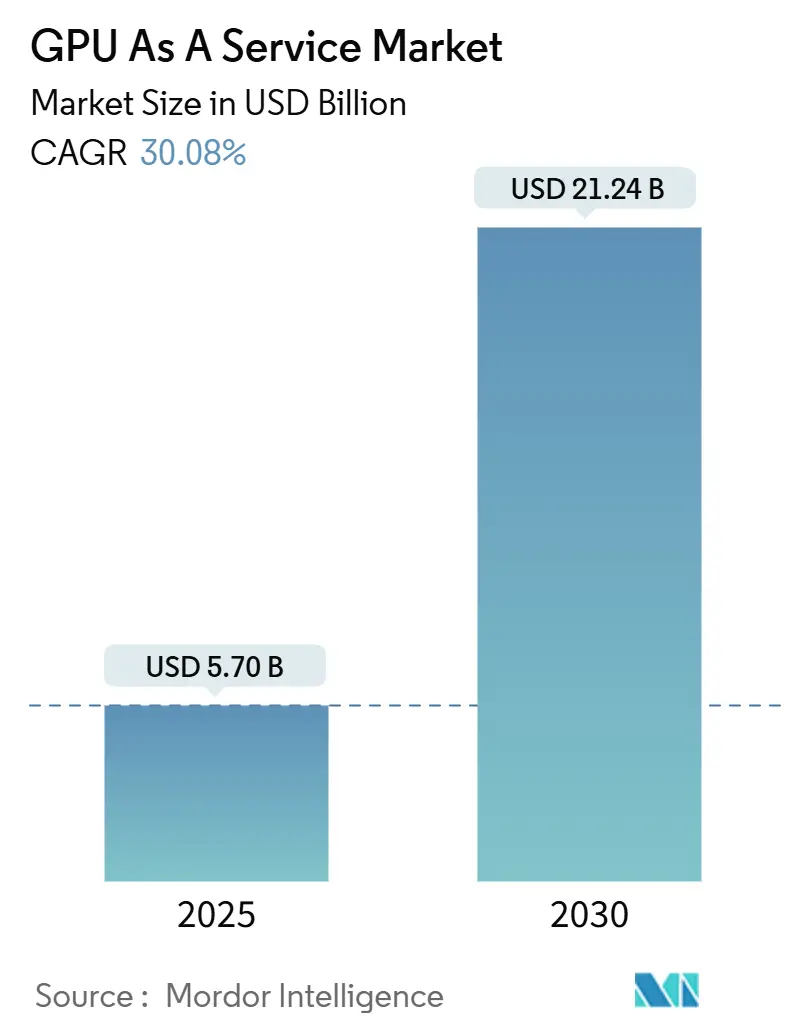
GPU As A Service Market Analysis by Mordor Intelligence
The GPU as a Service market reached a current value of USD 5.70 billion in 2025 and is forecast to advance to USD 21.24 billion by 2030, translating into a robust 30.08% CAGR. The GPU as a Service market draws momentum from the collision of generative-AI workloads, cloud-gaming adoption, and companywide digital-transformation projects that require elastic, high-density compute capacity. Pay-per-use models continue to shift budgets away from on-premises GPU clusters toward cloud subscriptions, while liquid-cooling retrofits enable data-center operators to pack more accelerators per rack and maintain power efficiency. Hyperscalers protect share through global scale, yet specialist “neoclouds” compete aggressively on price and workload-specific performance. Pricing ranges from USD 0.66 per hour for A100 instances to USD 4.00 and above for premium H100 configurations, giving customers flexibility across performance tiers.
Key Report Takeaways
By application, Artificial Intelligence held 47.3% of the GPU as a Service market share in 2024; Cloud Gaming and Media Rendering is expanding at a 31.2% CAGR through 2030.
By enterprise size, Large Enterprises led with 56.3% of 2024 revenue, whereas Small and Medium Enterprises are pacing at a 29.7% CAGR to 2030.
By end-user industry, IT & Communications commanded 32.7% revenue in 2024, while Healthcare and Life Sciences is projected to scale at a 31.5% CAGR during the same period.
By deployment model, Public Cloud captured 45.9% in 2024; Hybrid and Multi-cloud configurations are growing at a 30.2% CAGR.
By service model, Software-as-a-Service accounted for 52.1% revenue in 2024, whereas Platform-as-a-Service is set to rise at a 31.1% CAGR.
By geography, North America represented 31.4% of global revenue in 2024, but Asia-Pacific is advancing at a 30.5% CAGR to 2030.
Global GPU As A Service Market Trends and Insights
Drivers Impact Analysis
| Driver | (~) % Impact on CAGR Forecast | Geographic Relevance | Impact Timeline |
|---|---|---|---|
| Rising usage of generative-AI and LLM workloads | +8.5% | Global, with concentration in North America and Asia-Pacific | Medium term (2-4 years) |
| Surge in AR/VR and real-time rendering needs | +4.2% | North America and Europe, expanding to Asia-Pacific | Long term (≥ 4 years) |
| Cloud-gaming service expansion | +3.8% | Global, led by North America and Europe | Medium term (2-4 years) |
| Pay-per-use pricing models gaining traction | +2.9% | Global | Short term (≤ 2 years) |
| Liquid-cooling data-center retrofits unlocking GPU density | +2.1% | North America and Europe | Medium term (2-4 years) |
| Multi-cloud GPU-orchestration platforms reducing vendor lock-in | +1.7% | Global, enterprise-focused | Short term (≤ 2 years) |
| Source: Mordor Intelligence | |||
Rising usage of generative-AI and LLM workloads
Demand for transformer-based models drives unprecedented GPU clustering, with single projects consuming thousands of H100 accelerators for training cycles that last weeks. NVIDIA noted that 91% of financial institutions are now in production or evaluation phases for AI use cases.[1]NVIDIA Corporation, “BNY Mellon Deploys DGX SuperPOD,” nvidia.comFinancial-services firms such as BNY Mellon demonstrated the power of GPU superclusters for real-time fraud analytics nvidia.com. Elastic scaling inherent in the GPU as a Service market allows research teams to match compute supply with unpredictable training bursts. High-bandwidth memory (HBM) equipped H100 and H200 parts are favored because they maintain throughput for expanding parameter counts. The long tail of startups can now access the same silicon that hyperscalers deploy, leveling the innovation playing field.
Surge in AR/VR and real-time rendering needs
Photorealistic rendering at 90 frames per second strains consumer hardware, motivating developers to stream pixel-perfect frames from remote GPUs. NVIDIA’s CloudXR platform layers low-latency codecs onto GPU back-ends to deliver immersive experiences to thin clients. Pixel-streaming specialists such as Arcware offer Unreal-Engine-as-a-Service so that architectural-visualization teams can present interactive models on mobile devices. Manufacturing firms adopt digital-twin workflows that mix physics simulation with real-time visualization, pushing demand for distributed GPUs at the edge. As next-generation headsets arrive, content studios prefer the GPU as a Service market over purchasing bespoke render farms because they avoid capital costs and maintain flexibility.
Cloud-gaming service expansion
Platforms including GeForce NOW and Xbox Cloud Gaming run vast GPU fleets to stream 1080p and 4K sessions concurrently. Edge node build-outs keep latency under 40 milliseconds for fast-twitch genres, amplifying regional GPU footprints. Service providers cross-subsidize capacity during off-peak gaming hours by renting the same clusters to media-rendering and deep-learning customers, raising overall utilization. The GPU as a Service market thus benefits from multi-tenant economics that share capex burdens across entertainment, AI, and engineering verticals. Consumer adoption is further supported by 5G rollouts that increase bandwidth for handheld devices.
Pay-per-use pricing models gaining traction
Dynamic spot pricing led by Voltage Park and Lambda slashes entry costs for experimentation. Lambda’s 1-Click Clusters provision multi-node H100 setups in under five minutes, billing only for runtime. Serverless GPU services from Google Cloud Run now auto-scale to zero and charge per second, eliminating idle overhead.[2]Google Cloud, “GPU Support in Cloud Run,” cloud.google.com Transparent pricing forces hyperscalers to refine reservation discounts, while offering granular metering options down to one-second intervals. For developers, cost predictability accelerates prototype-to-production cycles without long procurement delays.
Restraints Impact Analysis
| Restraint | (~) % Impact on CAGR Forecast | Geographic Relevance | Impact Timeline |
|---|---|---|---|
| Cyber-security and data-sovereignty concerns | -3.2% | Global, acute in regulated industries | Short term (≤ 2 years) |
| Global shortage of AI-skilled DevOps talent | -2.8% | Global, severe in emerging markets | Medium term (2-4 years) |
| HBM memory and advanced packaging supply constraints | -4.1% | Global supply chain impact | Medium term (2-4 years) |
| Escalating data-center power tariffs and carbon regulations | -2.3% | Europe and regulated jurisdictions | Long term (≥ 4 years) |
| Source: Mordor Intelligence | |||
Cyber-security and data-sovereignty concerns
Shared accelerator pools create fresh attack surfaces, with research highlighting GPU side-channel vectors that bypass traditional hypervisor barriers.[3]Trend Micro Research, “Side-Channel Threats on GPUs,” trendmicro.com Confidential-computing extensions now encrypt memory and isolate workloads so that multi-tenant environments meet bank and government standards. Export-control regimes add compliance complexity because GPUs above certain TOPS thresholds require licensing before cross-border deployment. Sovereign-cloud frameworks push enterprises toward regional nodes, influencing data-center location strategies inside the GPU as a Service market. Providers respond with per-region key-management systems and cryptographically signed GPU-license enforcement.
HBM memory and advanced packaging supply constraints
Global demand for HBM3E far exceeds wafer-production and TSV-stacking capacity. SK Hynix and Micron report fully booked lines through 2025, raising input costs per GPU board. CoWoS-based packaging at TSMC remains another bottleneck, with lead times stretching past 52 weeks for high-end modules. Neoclouds with secured allocation agreements gain a pricing edge, while smaller players struggle to access flagship silicon. Sustained shortages risk extending refresh cycles and could restrain the GPU as a Service market size growth trajectory until new fabs come online.
Segment Analysis
By Application: AI Workloads Sustain Market Leadership
Artificial-intelligence use cases represented 47.3% of 2024 revenue, giving this segment the largest slice of the GPU as a Service market. Transformer architectures now exceed 1 trillion parameters, driving multi-cluster demands that only elastic cloud pools can supply. Large-language-model inference spans real-time chatbots, code-generation assistants, and enterprise knowledge retrieval, keeping utilization steady after training cycles complete.
Cloud Gaming and Media Rendering is the fastest-rising application group at a 31.2% CAGR, helping expand the GPU as a Service market size for entertainment workloads through 2030. Providers monetize evening gaming peaks and rent idle daytime capacity to film-render pipelines, elevating asset utilization. Hybrid workloads that simulate autonomous-vehicle environments blend photoreal rendering with physics-based AI, bridging gaming engines and AI frameworks in a single tenancy. As these cross-domain workflows normalize, application boundaries blur and every incremental project funnels additional value into the GPU as a Service market.
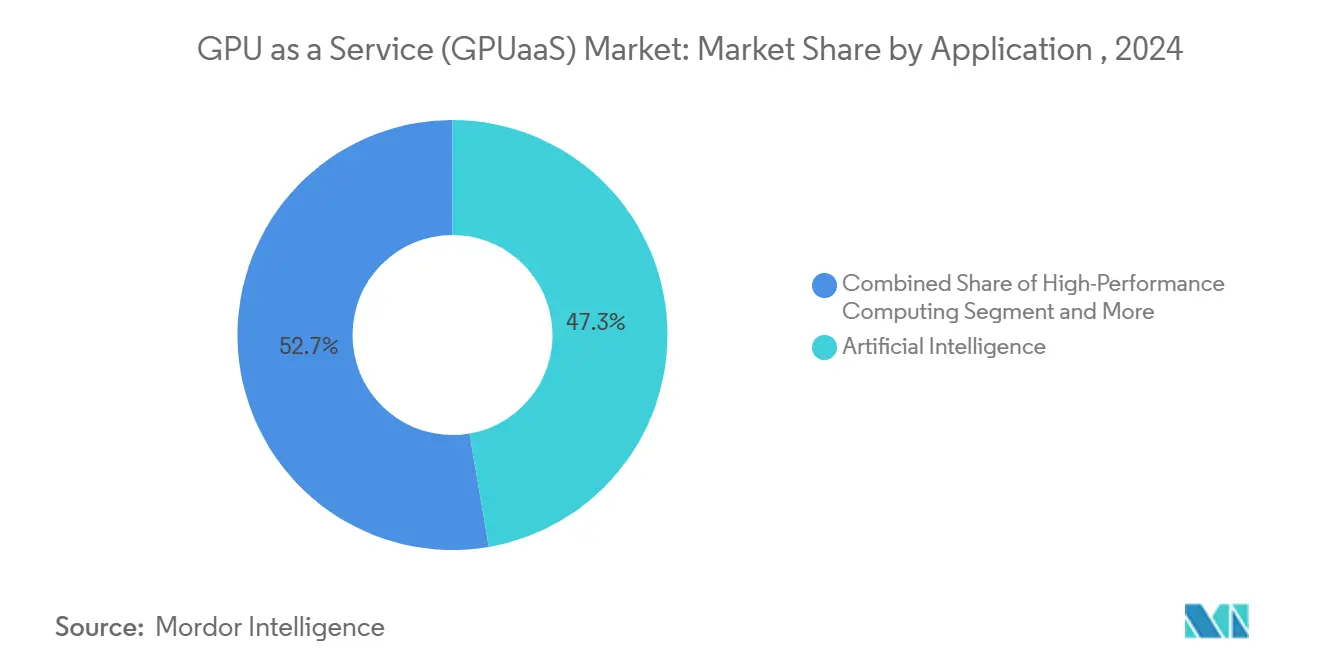
Note: Segment shares of all individual segments available upon report purchase
By Enterprise Size: SMEs Narrow the Gap
Large Enterprises secured 56.3% of 2024 revenue thanks to reserved-capacity contracts and dedicated support teams. Multinational banks, automakers, and pharmaceutical giants lock in multi-year blocks of H100 instances for predictable AI roadmaps. They often negotiate data-center colocation arrangements or direct-to-manufacturer supply guarantees, ensuring continuity during supply-chain shocks.
Small and Medium Enterprises are growing at a 29.7% CAGR, underscoring the democratization effect that consumption billing brings to the GPU as a Service industry. Serverless offerings remove the need for DevOps headcount, allowing lean teams to integrate vision models or recommendation engines into products within days. Competitive pricing at USD 0.66 per hour for A100s further lowers entry barriers, propelling the overall GPU as a Service market forward as SME participation deepens.
By End-user Industry: Healthcare Outpaces All Verticals
IT and Communications held 32.7% of 2024 revenue, reflecting the hyperscaler foundations of the GPU as a Service market. Telecom operators allocate accelerators to network-optimization AI that predicts traffic surges and automates energy savings. Media-streaming firms run real-time transcoders and recommender systems atop the same hardware, reinforcing utilization.
Healthcare and Life Sciences is set to climb at a 31.5% CAGR, the steepest rate among verticals, propelling segment contributions to the GPU as a Service market size. Drug-discovery platforms deploy generative chemistry models, slashing iteration time for molecule screening. Medical-imaging providers run GPU-accelerated DICOM pipelines that compress modality turnaround from minutes to seconds, improving clinician workflow. These achievements justify capital reallocation from legacy PACS to GPU-backed cloud analytics, reinforcing spend momentum.
By Deployment Model: Hybrid Architectures Gather Steam
Public-cloud nodes captured 45.9% of 2024 consumption because they deliver near-instant scalability and global reach. Training jobs with volatile demand benefit from the ability to burst thousands of GPUs overnight without procurement cycles.
Hybrid and Multi-cloud top the growth chart at 30.2% CAGR, bolstered by orchestration suites that abstract vendor differences and direct workloads toward the lowest cost-per-flop destination. Enterprises tether latency-sensitive inference to private GPU pods while bursting training to public regions, optimizing both performance and compliance. This balanced stance spreads spending across providers and expands the GPU as a Service market size allocation toward orchestration software that automates placement decisions.
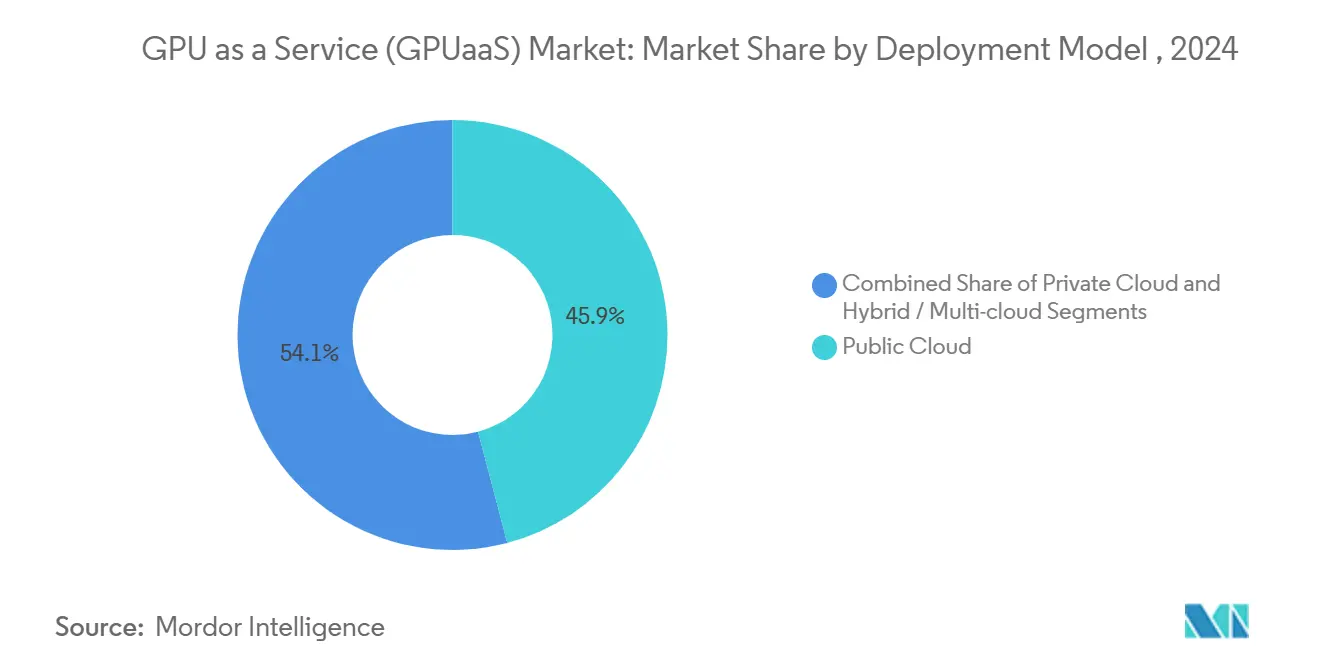
Note: Segment shares of all individual segments available upon report purchase
By Service Model: Platform Services Lead the Uptick
Software-as-a-Service APIs accounted for 52.1% of 2024 revenue, satisfying developers who want turnkey inference endpoints with integrated version control and monitoring. Popular examples include vision-classification endpoints and speech-to-text transcribers that hide GPU complexity behind REST calls.
Platform-as-a-Service is accelerating at a 31.1% CAGR, signaling a shift toward managed environments that still grant root-level CUDA access when required. Offerings such as Rafay’s GPU PaaS integrate cluster scheduling, cost governance dashboards, and ML-specific observability rafay.co. Developers remain productive while operations teams enforce budget and security policy from a unified console, keeping the GPU as a Service market attractive to enterprises that balance agility with IT control.
Geography Analysis
North America contributed 31.4% of global revenue in 2024 on the back of established hyperscaler footprints, vibrant startup ecosystems, and early adoption across banking, retail, and entertainment. Providers retrofit legacy halls with direct-to-chip liquid-cooling to achieve rack densities above 120 kW, enabling tens of thousands of GPUs per facility. Regional export controls shape where the most advanced silicon can be deployed, adding compliance consulting as a value-added service inside the GPU as a Service market.
Asia-Pacific is projected to post a 30.5% CAGR, reflecting government-funded AI clouds and manufacturing digitization. Singapore spends USD 600 per capita on NVIDIA hardware and offers tax incentives for AI infrastructure, positioning itself as a regional compute hub. India’s national mission to install 10,000 GPUs partners NVIDIA with domestic telcos for sovereign-cloud builds. Japan and South Korea accelerate procurement of H200 clusters for language-translation and robotics workloads, illustrating diverse catalysts that funnel regional budgets into the GPU as a Service market.
Europe balances growth opportunities with stringent sustainability and data-residency regulations. Providers invest in 100% renewable energy supplies and waste-heat re-use, aligning with EU carbon caps. Demand across automotive, pharma, and public-sector AI applications keeps utilization rising despite policy headwinds. Growth in South America and the Middle East & Africa lags in absolute terms but posts double-digit gains as broadband penetration improves and local AI ecosystems mature. Collectively, emerging regions will expand the addressable user base and further diversify revenue streams for the GPU as a Service market.
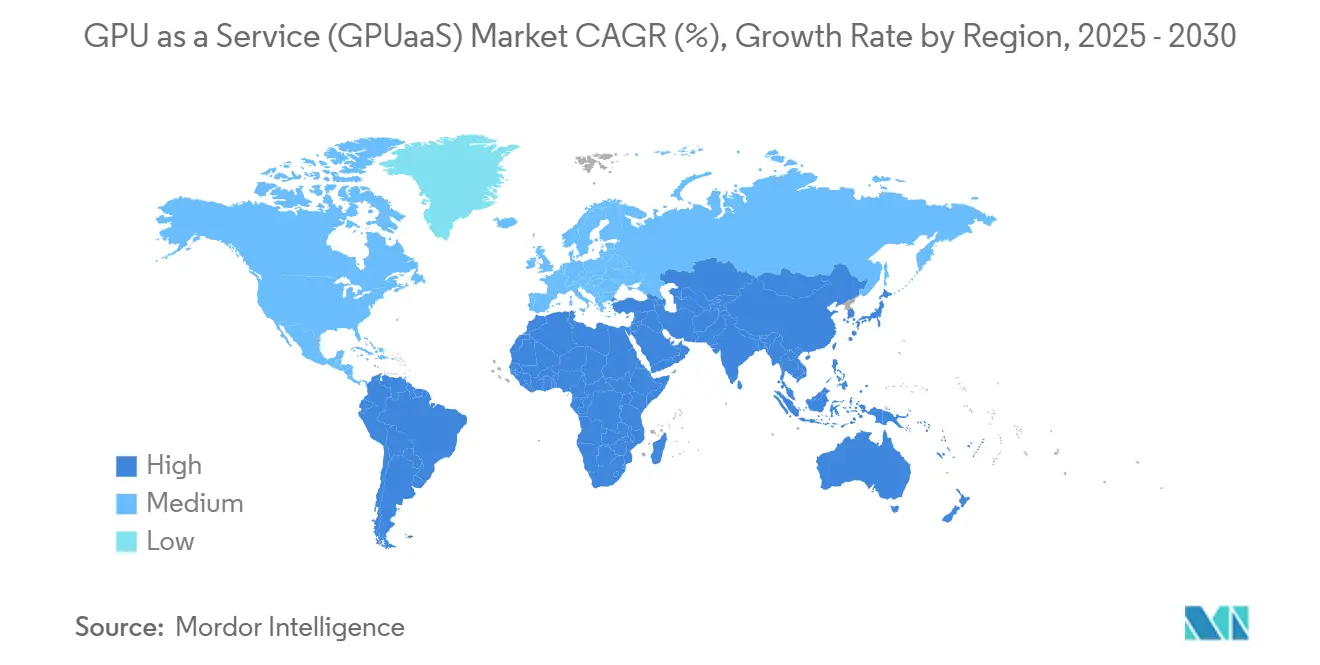
Competitive Landscape
Competition remains fierce yet moderately concentrated. AWS, Microsoft Azure, and Google Cloud bundle GPUs with broader cloud portfolios to defend incumbent accounts. Specialized players such as CoreWeave, Lambda Labs, and RunPod differentiate on bare-metal performance, faster provisioning, and lower hourly pricing, often enabled by direct partnerships with NVIDIA or AMD. Neoclouds pursue vertical specialization, for example CoreWeave’s focus on film-render farms and Lambda’s orientation toward research institutes.
Strategic moves underscore the tactical arms race. NVIDIA acquired Run:ai to fold advanced scheduling into its stack, letting customers raise GPU utilization without rewriting workloads. CoreWeave purchased Weights & Biases to integrate experiment tracking and model registry functions with compute, forming an AI-platform bundle that rivals hyperscaler ML studios. Google Cloud introduced per-second GPU billing and auto-scaling to zero for serverless workloads, appealing to developers who value operational simplicity.
Pricing transparency exerts downward pressure. Thunder Compute advertises A100s at USD 0.66 per hour, undercutting hyperscalers by up to 80%. Spot-market auctions pioneered by Voltage Park further commoditize idle inventory, benefiting price-sensitive SMEs while forcing larger providers to sharpen reserved-instance discounts. Confidential-computing and sovereign-cloud requirements foster new niches, prompting operators to spin up region-locked clusters with hardware-level encryption. These dynamics collectively shape purchasing decisions and reinforce innovation velocity across the GPU as a Service market.
GPU As A Service Industry Leaders
-
Amazon Web Services Inc.
-
Microsoft Corporation
-
Nvidia DGX (Nvidia Corporation)
-
IBM Corporation
-
Oracle Corporation
- *Disclaimer: Major Players sorted in no particular order
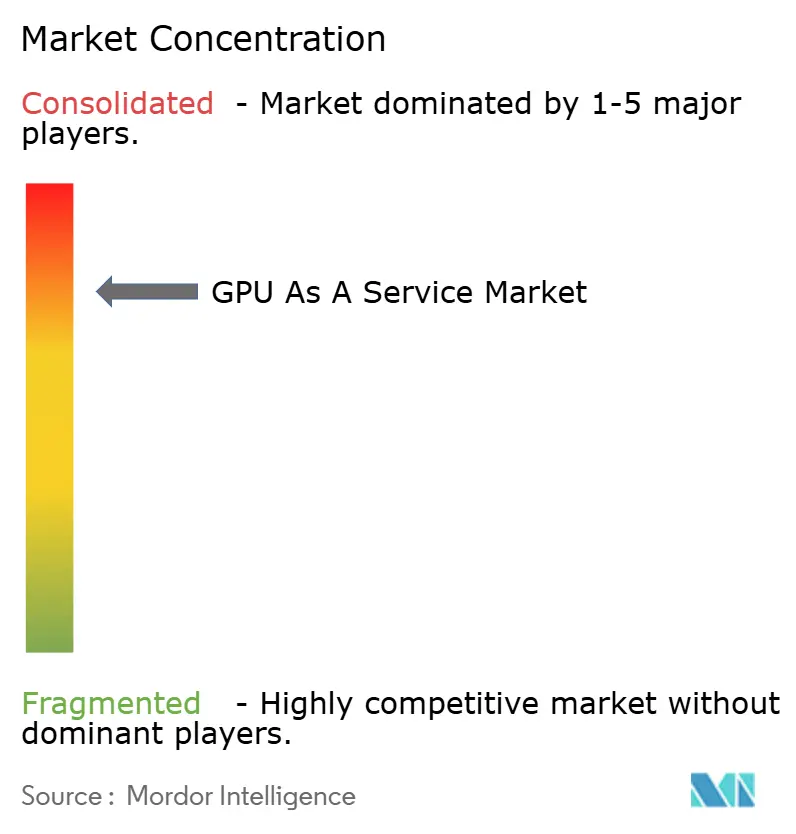
Recent Industry Developments
- June 2025: CoreWeave announced its role supplying compute capacity for new Google-OpenAI collaborations, extending its footprint in large AI partnerships.
- June 2025: Google Cloud made NVIDIA GPU support on Cloud Run generally available, featuring pay-per-second pricing and automatic scale-to-zero.
- May 2025: CoreWeave finalized the acquisition of Weights & Biases, integrating experiment-tracking tools into its platform.
- May 2025: TensorWave closed a USD 100 million funding round to expand AMD-based GPU infrastructure for cloud customers.
Global GPU As A Service Market Report Scope
GPU as a Service (GPU-as-a-S) is a cloud computing model that provides users with access to powerful graphics processing units (GPUs) over the internet. The market is defined by the revenue accrued through the sale of GPU as a service for various applications such as artificial intelligence and high-performance computing across end-user industries, including BFSI, automotive, healthcare, and IT and communication.
The GPU as a service market is segmented by application (artificial intelligence, high-performance computing, and other applications), by enterprise type (small and medium enterprises, large enterprises), by end-user (BFSI, automotive, healthcare, IT and communication, and other end users), and by geography (North America, Europe, Asia Pacific, Latin America, Middle East and Africa). The Report Offers Market Forecasts and Size in Value (USD) for all the Above Segments.
| Artificial Intelligence |
| High-Performance Computing |
| Cloud Gaming and Media Rendering |
| Other Applications |
| Small and Medium Enterprises |
| Large Enterprises |
| BFSI |
| Automotive and Mobility |
| Healthcare and Life Sciences |
| IT and Communications |
| Media and Entertainment |
| Other Industries |
| Public Cloud |
| Private Cloud |
| Hybrid / Multi-cloud |
| IaaS |
| PaaS |
| SaaS (GPU-accelerated) |
| North America | United States | |
| Canada | ||
| Mexico | ||
| South America | Brazil | |
| Argentina | ||
| Rest of South America | ||
| Europe | United Kingdom | |
| Germany | ||
| France | ||
| Italy | ||
| Spain | ||
| Rest of Europe | ||
| Asia-Pacific | China | |
| Japan | ||
| South Korea | ||
| India | ||
| Australia | ||
| Rest of Asia-Pacific | ||
| Middle East and Africa | Middle East | Saudi Arabia |
| United Arab Emirates | ||
| Turkey | ||
| Rest of Middle East | ||
| Africa | South Africa | |
| Nigeria | ||
| Egypt | ||
| Rest of Africa | ||
| By Application | Artificial Intelligence | ||
| High-Performance Computing | |||
| Cloud Gaming and Media Rendering | |||
| Other Applications | |||
| By Enterprise Size | Small and Medium Enterprises | ||
| Large Enterprises | |||
| By End-user Industry | BFSI | ||
| Automotive and Mobility | |||
| Healthcare and Life Sciences | |||
| IT and Communications | |||
| Media and Entertainment | |||
| Other Industries | |||
| By Deployment Model | Public Cloud | ||
| Private Cloud | |||
| Hybrid / Multi-cloud | |||
| By Service Model | IaaS | ||
| PaaS | |||
| SaaS (GPU-accelerated) | |||
| By Geography | North America | United States | |
| Canada | |||
| Mexico | |||
| South America | Brazil | ||
| Argentina | |||
| Rest of South America | |||
| Europe | United Kingdom | ||
| Germany | |||
| France | |||
| Italy | |||
| Spain | |||
| Rest of Europe | |||
| Asia-Pacific | China | ||
| Japan | |||
| South Korea | |||
| India | |||
| Australia | |||
| Rest of Asia-Pacific | |||
| Middle East and Africa | Middle East | Saudi Arabia | |
| United Arab Emirates | |||
| Turkey | |||
| Rest of Middle East | |||
| Africa | South Africa | ||
| Nigeria | |||
| Egypt | |||
| Rest of Africa | |||
Key Questions Answered in the Report
What is the projected revenue for the GPU as a Service market by 2030?
The GPU as a Service market is expected to reach USD 21.24 billion by 2030, reflecting a 30.08% CAGR from 2025.
Which application currently dominates the GPU as a Service market?
Artificial-intelligence workloads hold the lead with 47.3% of 2024 revenue, driven by large-language-model training and inference needs.
Why are Small and Medium Enterprises adopting GPU cloud services rapidly?
SMEs benefit from pay-per-use pricing as low as USD 0.66 per hour and serverless provisioning that eliminates the need for dedicated DevOps staff, resulting in a 29.7% CAGR through 2030.
Which geographic region is growing fastest in GPU cloud adoption?
Asia-Pacific is set to expand at a 30.5% CAGR, propelled by sovereign-AI programs and manufacturing digitization initiatives.
How are supply-chain constraints affecting GPU availability?
Limited HBM memory and advanced CoWoS packaging capacity constrain high-end GPU production, elevating prices and favoring providers with secured allocations.
Page last updated on:
